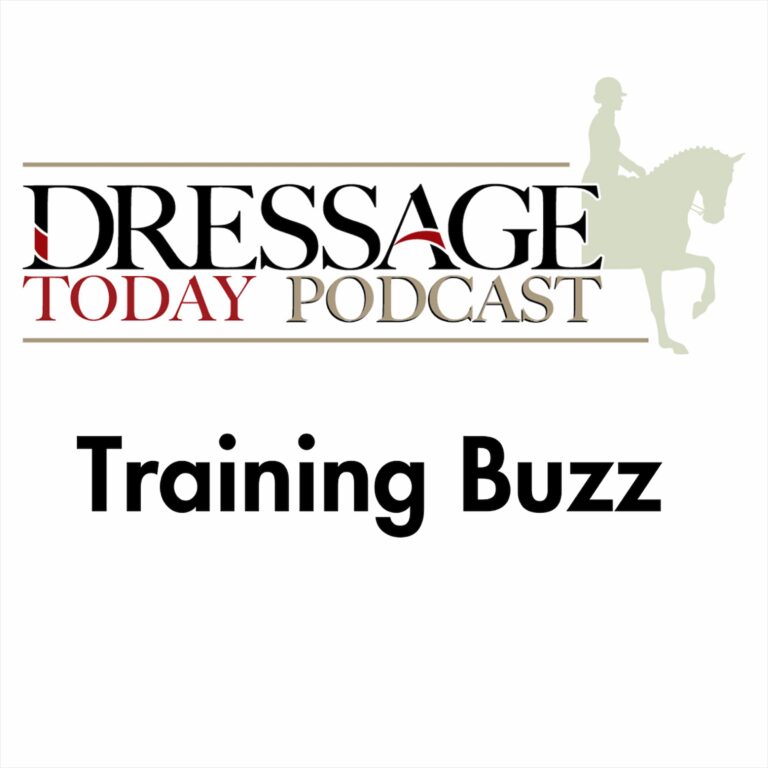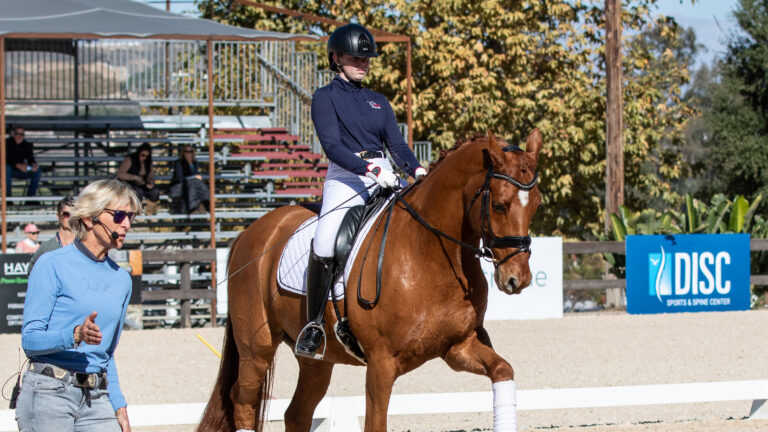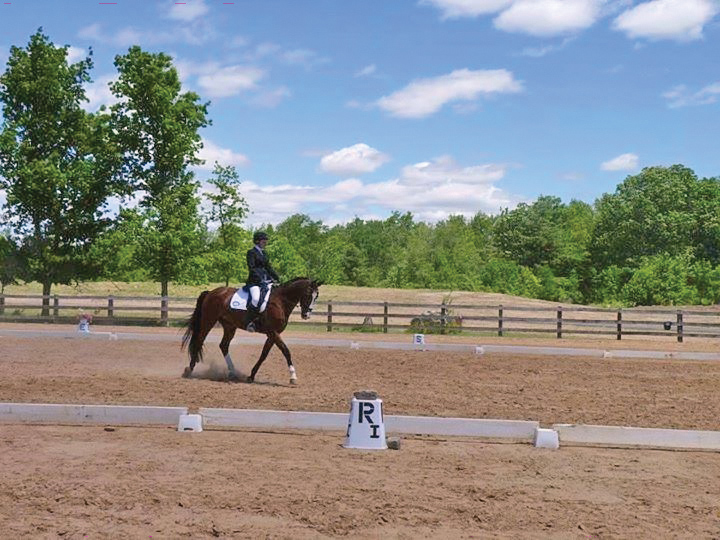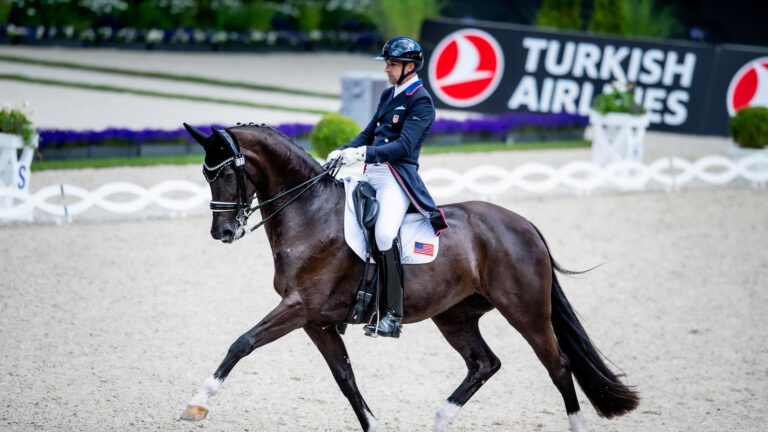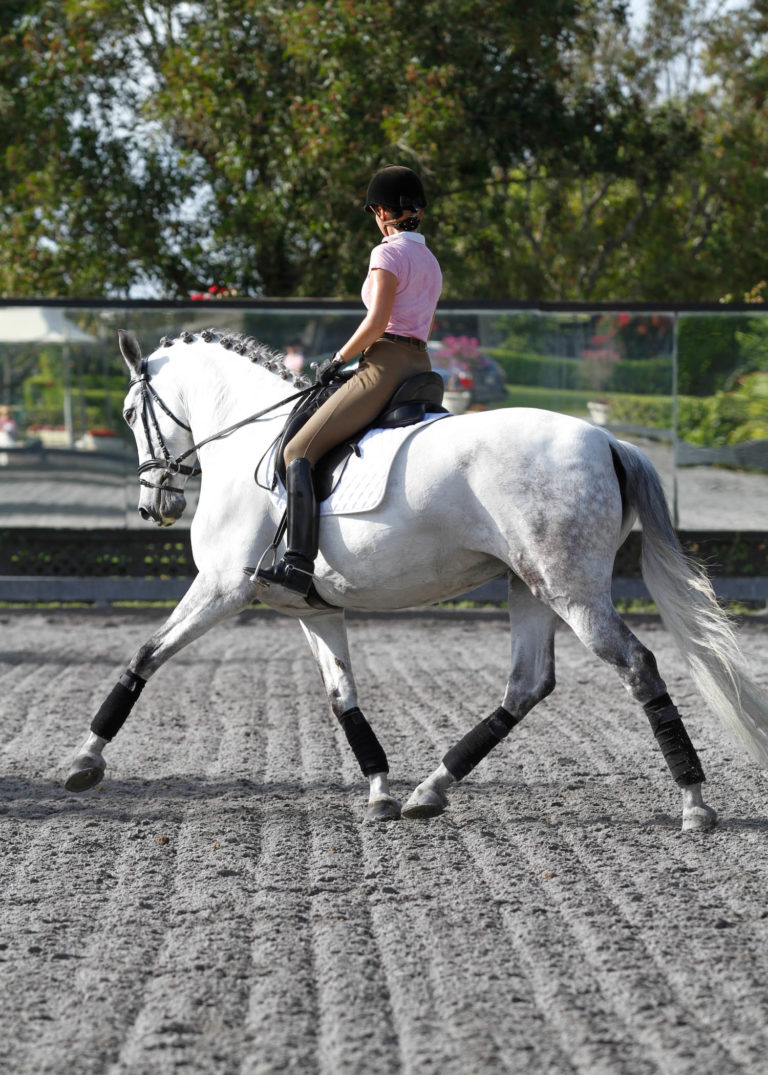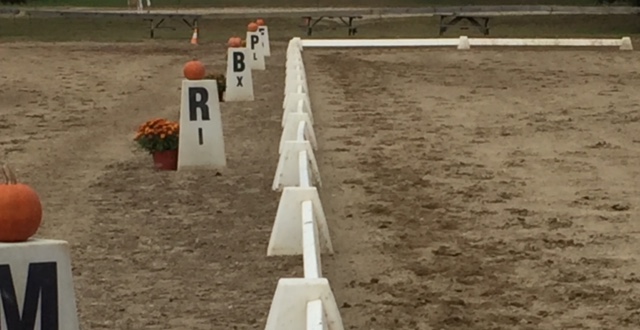
If you’ve ever wondered what separates a 65 percent from a 70 percent, you are not alone. Many riders at some point in their careers find themselves consistently placing in the middle of the pack and feeling a little stuck. They practice their test diligently, they listen to the advice of their instructors, they study their peers and they do well, but can’t seem to break into the top of their class. We asked three of the world’s best judges: How can we ride a winning dressage test? Here is their advice.
1. Ride Centerlines
Our first expert, Anne Gribbons, FEI 5* judge and U.S. dressage coach from 2010 to 2013, encourages riders to incorporate centerlines into their daily work. “To ride a centerline correctly you need a good degree of balance and straightness. The horse must be even on both reins and obedient to the half halt. The entrance must be straight, the downward transition must be smooth and the halt square. The horse must stand at attention, with his nose on the vertical, ready for the upward transition, which must be prompt and energetic. This is the first thing that the judges see and it will make an impression. The problem is that many riders are not comfortable riding on the centerline. They do all kinds of exercises to supple the horse, but they don’t ride him straight down the centerline. Straightness is not the very first level of the Training Scale, but it is one of the more important ones and it should be addressed fairly early in the horse’s training.
“Now let’s talk about the downward transition to halt and its preparation,” continues Gribbons. “When the horse trots or canters down, he must be balanced over his hind legs so that his front legs come down like snowflakes on the ground. He has already taken the weight behind so he is sitting down a little bit. Then he drops his front legs down and he is perfectly square. And that kind of a halt looks good from all angles. He should then stand, immobile and attentive with his nose on the vertical, and wait for the rider’s forward aid. The transition upward must be engaged and energetic, and that is not so easy after the horse has been standing stock-still. If the horse is the least bit behind the leg, it will not look good. He will take the first step with the front legs and shuffle forward.”
Practice is really the only way to perfect a centerline, says Gribbons. “Incorporate centerlines into your daily work. Practice going down in trot or canter and shortening the strides as if preparing for halt, but keep moving. It is important to vary where you halt on the centerline and also to ride down the centerline many times without halting at all. The horse must always think “forward” and not anticipate the downward transition. It’s the horse’s responsibility to keep moving until you ask him to stop. Ride this line habitually until your horse is totally comfortable going straight and is waiting for your directive whether it’s a pirouette, leg yield or a halt.”
2. Disciplined Transitions
Another thing that impresses our judges is clear and confident transitions, particularly downward transitions. Gribbons says that she doesn’t often see excellent downward transitions. “I see a lot of horses who can do forward transitions, but then the down transition is not nearly as crisp.”
She adds that transitions, although important at all levels, are especially important in lower levels, where they are really the meat of the test. “What is there that really separates a good rider from an excellent one when the lower-level tests have fewer movements? It is all transitions! Being disciplined at the beginning of the training will serve you well as you continue up the levels because there will always be transitions—now it is trot to canter, but eventually it will be canter to halt or passage to canter. Of all the tools that we have to train a dressage horse, the most important tool in the box is the transitions. The uphill balance, throughness and obedience that come with practicing transitions is the basis for everything at the upper levels.”
Transitions are another thing that our judges feel improve with repetition. But as the saying goes: Practice does not make perfect, perfect practice makes perfect. Riders must be picky about the horse’s responsiveness to the aids and his balance as he moves into the next gait. FEI 5* judge Lilo Fore explains how to maintain this balance in the downward transition: “It is very important for the rider to remember that the down transition has a forward action rather than a stopping action. Training the horse to rotate the pelvis and lower the croup will not happen overnight. It is a process which takes time and careful consideration. My explanation to the rider is to think of a downward transition as a new beginning to a new gait rather than the end of the gait they were in. They must always think uphill, even in a downward transition.”
Fore says to think of an airplane. “Airplanes land on their rear wheels first. I would like my horses to be like a well-flown plane, so the rider must learn to be a good pilot. When training transitions in this way, the horse will become more horizontal in his outline. From there he can learn how to bend behind the saddle in the loin and sink through the joints, allowing the hind legs to bear weight and not just cover ground. In the future, this will lead to lightness of the forehand and self-carriage. Engagement will begin, which can develop into collection and a degree of cadence. This is the magic of developing and enhancing our horses’ gaits and paces.”
3. In a Dressage Test, The Directives Give You The Answers

Many riders, when learning a new test, study the movements diligently, but Fore thinks they should pay more attention to the directives in the next column: “Most riders know the required movements, but not the directives, and that is what we judges pay attention to,” she says. “We look to see how the horse is ridden in these required exercises. Is the horse ridden to the contact? Does he maintain rhythm and regularity in all gaits? Does he show a degree of suppleness appropriate for his level? Does the rider keep a tempo that facilitates balance? Even for a simple circle the directives are explicit: ‘consistent bend around the rider’s inside leg, placement and control over the size of circle, reach to the bit and the quality of the gait.’ The directives mention these important details and more.
“The movements are only beneficial if the directives are addressed,” Fore continues. “It takes focus and preparation, as well as mental and physical awareness of how the horse responds to our aids. Make the arena your friend—corners and circles are not the enemy! Learn to activate the horse’s engine on these curved lines and send him into the contact. Impulsion and connection should always be maintained even when bend is needed for an upcoming corner, circle or lateral movement. The letters of the arena, the distance between them and the circle points must be understood by the rider in order to train the horse correctly. Riding accurately will help to teach acceptance of the aids and the contact. Without that we have nothing. So when you practice your test, do more than just ride the movement. Ride the movement and answer all the questions, meet the requirements of that movement as stated in the directives.”
4. Go Back to Basics: Develop the Quality of The Gaits
Olympian and “I” judge Hilda Gurney encourages riders to look past the required movements and really examine the quality of the horse’s gaits and how it can be improved: “I think most riders do not focus on one of the foremost goals of dressage, which is the development of the gaits. To develop the horse’s gaits, the rider has to have a supple, balanced seat and ride the horse from back to front. Only then can you have the horse really through and even on both reins. From there you must ride the horse boldly forward within his tempo.
“If you look at the FEI Training Scale, rhythm is the first thing to come and, often, the first thing to go!” Gurney continues. “Riders need to remember that impulsion does not mean ‘go faster.’ Impulsion comes from balancing the horse between the aids and making him more supple and responsive. Riding forward to the bit, but in balance, improves the horse’s gaits, whereas quickening the tempo and going faster push the horse out of his natural rhythm and diminish the quality of the gaits.”
Gurney believes that riders are often unsure of how to develop the uphill balance that improves the power and clarity of the gaits: “I think the most important thing for riders to remember when improving the gaits is to ride back to front so that the horse reaches for the bit without getting too low. You see some lower-level riders ride the whole test practically in a long and low frame. Stretching is a really good exercise for developing suppleness in the back, but it should be done in moderation, as it can encourage the horse to travel on the forehand. Eventually the horse must be on the bit and ridden uphill. I often see lower-level riders try to develop the uphill balance by pulling back. They are more worried about the headset than truly riding the horse through from the hind legs. It is only by strengthening the hind end and developing pushing power that a horse can be connected and uphill. This is why riding properly forward is so incredibly important.”
One mistake that our judges often see in regard to the quality of the gaits is riders sacrificing the suspension in the canter. Gurney expounds on the qualities of a good canter: “The important thing in the canter is to try to keep that jump because a lot of riders, in trying to collect the canter, make the canter flat or, in trying to build power, will often rush the tempo. The most important thing is to hear the rhythm of the canter. You can hear the good canter, and it isn’t one–two–three. There is a fourth, silent moment that indicates suspension. When a horse becomes tense, that moment is lost and the tempo is a hurried one–two–three, one–two–three.”
Probably the most difficult gait to improve is the walk, but Fore tells riders not to be afraid of educating the walk in their training: “How many times do we ride and educate in the trot and canter and yet we are afraid to train the walk? Practice lengthening the strides, shortening the strides, doing transitions involving walk, and educate! Let the horse stretch in the walk, then shorten the reins into medium walk and try a few shorter steps toward collection, then back to the medium walk. Walk over poles to train the horse to lift his legs. There is nothing wrong with training the walk. Most problems in the walk occur because the rider allows the gait to get too slow and the frame gets short but the strides are not shortened or lengthened. The horse must be just as honest in the contact at the walk as he is in the trot and canter. The important thing is to never lose the forward desire when working in any gait.”
5. Make Corners A Habit

Our judges unanimously agree that corners are an underutilized part of every dressage test. Gribbons remarks, “Going into the corners is another thing that is not so hard to practice and makes a lot of sense because it provides an extra step or two to prepare your horse. But many riders neglect them, which is unfortunate because then they can’t turn onto that diagonal or down the centerline and have their horses straight and balanced. This seems like a small detail, but it’s very important because in today’s competition if you want to win, you have to pay attention to all these small things. Otherwise, you will not understand why—although your changes were brilliant and your extension outstanding—you did not win.”
Gribbons feels that riding corners is a habit that must be made at home. “Every corner is a quarter of a 10-meter circle. You are going to come in straight, bend for about two steps, straighten and then you’re done. And if you do this in every corner it will become second nature. It is something that is done in a few seconds, but it gives you a huge advantage: an extra step to prepare, a little more suppleness training, a moment to test your horse’s obedience, a chance to collect your thoughts before the next movement. As you move up the levels, your success will be determined by how well you use the space and time you are given in the test.”
6. Refine Your Aids to Increase Responsiveness
Gurney brings up the important subject of refining the aids. “One thing I really like to see when people ride the test are subtle, refined aids. I think when aids are really loud and disruptive to the horse it does not make for a harmonious picture. The rider must become fit and disciplined enough to train the horse to respond to quiet aids,” says Gurney.
It often happens that when riders practice at home they feel confident making corrections, but in the ring they sometimes freeze and feel the need to hold the horse together. Gurney thinks that this often happens because riders do not insist on their horse being responsive to the aids.
She says, “Riders, especially amateur riders, are often too worried about themselves making a mistake and forget to hold the horse accountable for being attentive to their aids. It is a vicious cycle in which the rider often ends up sacrificing her position, preventing her from riding effectively.”
Gurney also stresses that the rider’s timing is important to developing responsiveness to the aids. “The horse has to learn to respond within the tempo. This is what makes dressage different from reining or jumping. A reiner or a jumper must respond instantly. Therefore, he has to keep his feet on the ground. If a horse knows that he must respond to a turn at any moment, he is not going to give you as much of a suspension period because he needs to be pushing off the ground to respond. He stays low to the ground and takes small, quick steps. In dressage, we want that suspension and you can’t have a horse ready to respond at any moment and have suspension. You must teach him to respond within the tempo like a ballet dancer who must move in time to the music.”
7. Don’t Rush the Rein-back
The rein-back is a movement that riders have trouble with all the way up through Grand Prix. Gribbons believes that problems arise when riders do not carefully train and practice the rein-back as part of their regular work: “Often the horse comes into the ring and looks confused when the rider asks for a rein-back, as if they have never practiced. I think a lot of this confusion comes from how horses are taught. I personally believe that the rein-back is not a natural movement for a horse and that it can be a little frightening for them. Horses do not feel comfortable going back like that because it sets them up as prey. So if the horse is taught in a forceful way with the rider pulling on the reins, it is likely he will panic and freeze up or run backward. This is why I train the rein-back in a very specific way.”
Gribbons continues, “In the ring, the rein-back is either a testament to the suppleness and throughness of the horse or just the opposite! Movements like the rein-back are the real point-getters. Most horses today can do the exciting movements: the extended trot, half passes and changes. So what separates a great pair from an average pair is being able to do both!”
8. Perfect Your Pirouettes

Gribbons feels that riders often overlook walk pirouettes. “Let’s look at the Prix St. Georges. For the flying changes we get one score for each line, and we have now practiced them hundreds, if not thousands, of times and we are aggravated to death if one change isn’t clean. But then I sit and judge the Prix St. Georges and I look at the half pirouettes at the walk, which very often look as if the horse is not quite sure about what the rider wants. A thousand things can go wrong with this half pirouette at the walk: The horse can plant his hind legs, spin around too quickly, come above the bit or become lateral. So now you get a 5 for the half pirouettes at the walk. Wouldn’t it be great if you could have gotten a 7 or an 8 instead? You do not get paid more for that whole line of changes than for the half pirouette, and the pirouette is not so difficult to get right. And I know why you don’t practice it—because it’s boring. Yes, it’s boring, but, boy, if you practice that enough and it looks good, it’s an impressive thing to collect points on,” says Gribbons.
Fore also finds that riders do not understand the difference between turn on the haunches and pirouettes. “The difference is not just the size but the walk for the pirouettes must now show a shortening or collecting of the walk strides. The circle that the hind legs travel on in the turn on the haunches is up to 2 feet in diameter and is ridden from a medium walk, which is then slightly shortened.
“The pirouette, on the other hand, is ridden in collected walk with the hind legs stepping as much on the spot as possible,” Fore continues. “This can be a tricky thing to achieve. If the haunches are leading even slightly in the turn, the forehand will have trouble turning and the hind legs will get stuck or the horse will think backwards or maybe even turn in the middle. The horse’s shoulder must therefore be in a slight leading position, otherwise the front legs cannot cross in front of the rider and the hind legs will eventually get stuck.”
9. Establish Balance to Achieve Harmony
Harmony is a word that we find on every dressage test, but many riders find this to be an elusive quality. Fore says that harmony can be achieved only when the horse is balanced and comfortable and the rider has developed the ability to give clear, effective aids. It is a meeting of minds, a mutual understanding that the rider is the leader and will move the horse’s body in a way that maximizes his comfort and freedom of movement. In order to facilitate this, the horse must trust and comprehend the rider’s cues so that he becomes suspended between her quiet, accurate aids. A pair that is connected in this way looks as if they are moving as one. It is the ultimate depiction of balance and the high-wire act of dressage.
Fore emphasizes that harmony does not occur overnight. Balance must be built and tested and along the way, the horse and rider should break out of their comfort zone. She urges riders not to avoid manipulating the horse’s body, whether that be through frequent changes of direction or moving between different types of lateral work or changing the length of the frame and stride. This work teaches the horse to be attentive to the rider and improves his balance. She adds, “Only when the horse is balanced between all of the aids is harmony possible.”


